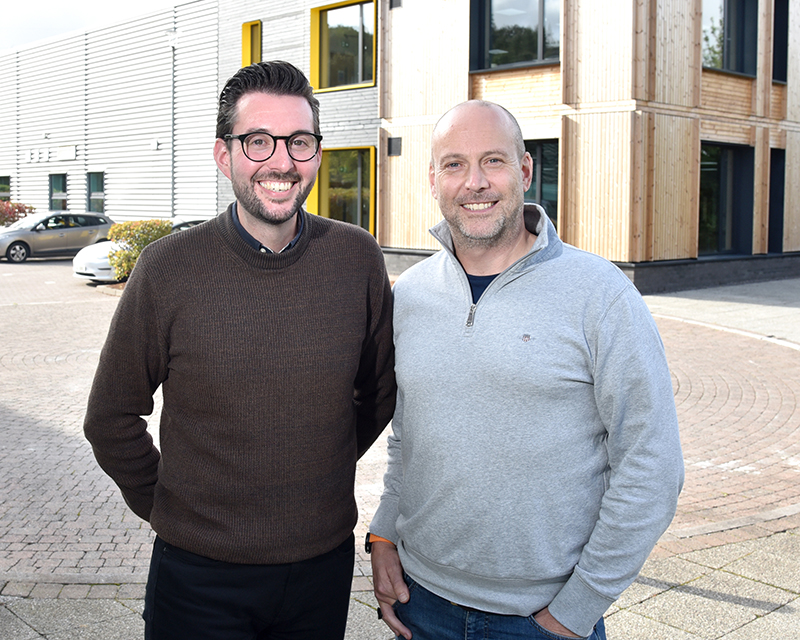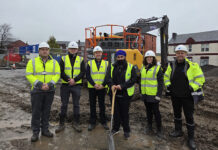
SCOTLAND’S construction and built environment professionals are being urged to make the most of two new facilities at BE-ST’s Innovation Campus in a bid to accelerate decarbonisation goals and capitalise on greater commercial opportunities.
BE-ST (Built Environment – Smarter Transformation) has officially launched its new Mass Timber Centre of Excellence and Scotland’s newly retrofitted National Retrofit Centre at the organisation’s campus at Hamilton International Technology Park.
The Mass Timber Centre of Excellence, which has been supported by Scottish Funding Council and host institution Edinburgh Napier University, offers organisations access to advanced timber manufacturing capabilities.
The site boasts the UK’s largest commercially available CNC machine, alongside the latest innovations to assist in the production of Cross Laminated Timber (CLT), Nail Laminated Timber (NLT), and Glued Laminated Timber (GLT). £1.5 million has been invested in equipment and the site will be capable of an annual output of some 8,000m3 when operated at full capacity on a single shift.

Scotland’s National Retrofit Centre (SNRC), meanwhile, has reopened following a deep retrofit delivered by Clark Contracts and part-funded through Phase 1 of Scotland’s Public Sector Heat Decarbonisation Fund. The aim of the facility is to help address the challenges of retrofitting existing buildings to make them more sustainable. The centre provides a space for both training and demonstrations of retrofit technologies.
Sam Hart, associate director of manufacturing at BE-ST, told Project Scotland that his ultimate aim for the Mass Timber Centre of Excellence is that it will better educate designers, engineers, and specifiers to aid in the design of buildings that utilise homegrown mass timber.
He said, “The old adage is ‘more buildings in timber, not more timber in buildings’. From a circularity perspective, we obviously don’t want to just fire loads of timber in buildings that isn’t necessary. Scotland builds 92% of its houses using timber frame. It’s the most resource-efficient way of constructing houses. When you start to look at larger structures – potentially apartment buildings or schools, hospitals, prisons, or even community asset-type projects – those are the kind of projects likely to potentially be displacing concrete and steel.”
Sam believes increased adoption of homegrown timber is ‘essential’ in helping Scotland meet ambitious environmental goals, adding that the scale of opportunity south of the border is even higher given the lack of residential properties currently being constructed using timber in England. The potential to take Scottish expertise and manufacturing into other parts of the UK is substantial, with Sam highlighting the number of volume housebuilders that have either invested in buying timber frame manufacturers or created their own in-house operations.
“I think it’s a very effective and simple way to look to reduce the embodied carbon in buildings by utilising naturally renewable materials,” he added.
Innovative organisations such as Ecosystems Technologies are already using the centre to great effect. As the first commercially available manufacturing facility of its type in the UK, Sam revealed the offer to utilise the equipment and advance low carbon approaches to construction is open to every industry partner.
“In addition to the equipment here, they’ve got the expertise of the team and the backing of an established and now mature Scottish supply chain. We’ve got a variety of sawmills, timber producers, driers. We’ve got a host of academic institutions that can come and support the work they’re doing. In addition to the manufacturing facility producing commercially available mass timber, we are continuing on the R&D journey where we want to look to iterate innovation in terms of product development, but also systems, processes, and products right the way through. It’s a call to arms. Come and speak to us.”
Sam described sector feedback to the centre as ‘very positive’. BE-ST is currently speaking to several organisations and hoping to collaborate with industry partners on a commercial basis.
“This is not BE-ST delivering mass timber to the market,” he explained. “It’s working with industry partners to deliver commercially. We are being approached by several architectural practices, engineers, designers, specifiers, who weren’t previously aware that this type of thing was available. They are now aware mass timber is an option, and utilising homegrown timber is an option, because the reduction in carbon miles coming from Europe and the value add of utilising local supply chains, enhancing Scottish forestry resources, the added economic, social, environmental benefits – it all adds to the fact that we can offer mass timber.”
Every piece of timber used within the site to manufacture the mass timber is graded at C16. Sam revealed European imports will be C24, which is ‘potentially overengineered’ and therefore the likelihood is the client will be overpaying for a product.
“We are using lower grade material to produce a more resource efficient product, thus hopefully saving the client money,” he added. “If we can drive that greater adoption from designers, specifiers, and engineers, then obviously that will enhance the manufacturing here, so we will help support the growth of organisations that use the centre. More widely, it will support the decarbonisation of the built environment.”
Gavin Johnston, associate director of collaborative and commercial partnerships at BE-ST, led the retrofit of the SNRC. He told Project Scotland the approach taken was to apply everything that BE-ST has championed over the last decade and put that into practice.
The project has taken the whole built environment ecosystem on a shared journey with BE-ST and been delivered on an ‘open book’ basis, resulting in it often being referred to as a ‘warts and all’ study of what it actually means to retrofit a building of that type.

“Across retrofit, anyone who’s worked in that sector and is familiar working in existing buildings, knows there is commonality across all projects regardless of whether you are talking about retrofit of your house or a university estate building, or former industrial unit,” Gavin said. “There are learnings that can be shared, and all of those opportunities and challenges remain consistent throughout projects.”
BE-ST plans a multiple phase investment in the SNRC. The long-term ambition is to meet the EnerPHit standard, which is the equivalent for retrofit to Passivhaus. That wasn’t the aim in this Phase 1 project, however.
“We’ve taken out the gas boiler and replaced it with an innovative hybrid heat pump system,” Gavin added, “as well as installing a new facade system, new windows and doors, a new suspended insulated roof system, new mechanical ventilation and heat recovery system, new LED lighting and LED lighting controlling system, and some provision for renewables through solar generation.”
Gavin revealed that every building in the country is, to some degree, going to have to undergo an element of retrofit in order for Scotland to meet its net zero targets. In some cases, this will simply involve a new heating system. In others, fabric improvement measures will be necessary.
To achieve this, he highlighted the importance of attracting fresh talent into the industry and having a skilled workforce capable of transitioning to a decarbonisation agenda and learning new skills and new ways of working.
“We need people with the skills and knowledge of how things actually work, how they go together, and who understand the theory in order to translate this into practice, especially as we target higher energy performance. We have to be more hands-on in terms of our understanding of how different things connect, how one thing affects another, how your work downstream affects someone else, and we have to have assurance of build quality.”
As well as adopting an open-door policy throughout the build process, BE-ST is keen to engage as much as possible with organisations interested in learning more about retrofit techniques.
“We are showcasing a lot of different solutions for people to come in and learn from what we’ve done,” Gavin added. “We’re also inviting people to showcase other alternative options, share with us through our Retrofit Scotland platform other case studies of what can be applied and where.
“What we want is a living lab essentially where you’ll be able to scan the QR code, see who’s been involved, learn about the materiality of it, ask the question of could this work in our scenario. We’re also aware it’s not a ‘lift and lay’ model. There’s still phase 2, 3, and 4 to come.”
Gavin stressed the need for a holistic building by building approach to retrofit rather than a one-size-fits-all methodology.
“You may want to take a building and go from start to finish to EnerPHit. You may want to take a phased approach. You might want to just decarbonise your heat source. You may want to do fabric measures. It doesn’t mean there has to be an overarching ethos. There will be a particular circumstance for everything and we’re an incredibly skilled sector where we have these solutions. What we need is for people to push towards the highest possible standard that they can achieve.”
In terms of the Scottish construction sector’s overall attitude towards sustainability, Gavin revealed there are people ‘really pushing the boundaries of what is possible,’ but added that he is sympathetic to the fact firms are fighting on multiple fronts.
“Sustainability is something that we focus on, but it may be just one aspect of someone else’s view of the landscape,” he stated. “To reach a broader audience our message is one of better, faster, more affordable, sustainable across all aspects of the sector. In terms of sustainability, it’s a piece of what is a complicated jigsaw puzzle. I think more broadly the sector’s moving towards adoption of more sustainable practices, engaging with it more, and crucially engaging with us as well and rising to the challenge.”
Sam agrees. He touched on the fact this is quite a traditional sector but believes there is a genuine appetite to embrace new solutions and innovative technologies.
“There are people out there, as Gavin says, really pushing the boundaries. There are organisations doing the minimum because that’s the best way to offer profit to shareholders, but everybody, almost without exception, is on an upwards trajectory towards improving the sustainability of their organisations.”
Low Carbon Passport programme to upskill workers across Scotland
ONE of the key aims of both new BE-ST facilities is to help close well documented skills gaps. Over the next decade, almost every project will need to meet tougher standards on energy efficiency and carbon reduction.
That means the skills required on site and at work are shifting, and everyone in the supply chain has a role to play.
From electricians wiring up energy-efficient systems, to joiners installing airtight detailing, painters and flooring specialists working with new materials and finishes, or anyone working in a building that might have these systems and solutions installed – low carbon knowledge is essential.
To tackle this challenge, BE-ST, in partnership with Tier 1 contractors including Balfour Beatty, Robertson Construction, Morrison Construction, Kier, and Morgan Sindall, has launched the Low Carbon Passport.
Funded through the CITB Industry Impact Fund, the programme will upskill 1,200 construction workers across Scotland by December 2026. It is fully funded – meaning it is free to take part in – and designed specifically to give workers across the trades the knowledge and confidence they need to deliver or work within high-quality, low energy buildings.
The Low Carbon Passport has been developed in collaboration with industry and colleges to meet the real needs of those working on site. The programme combines online modules, allowing participants to learn at their own pace, and in-person sessions offering hands-on training delivered across Scotland.
Topics range from the fundamentals of low energy buildings to detailed modules on fabric performance and ensuring systems are installed and performing correctly. Participants will receive a certificate on completion.
BE-ST said that with the shift to low carbon construction underway, public sector clients, housing associations, and developers are demanding higher standards. Future work opportunities will increasingly be tied to knowledge of low carbon building practices.
Previous participants in Low Carbon Passport are said to have enjoyed that the course focused on hands-on learning, and that it covers topics such as how to test the effectiveness of insulation installed and the processes and systems behind retaining heat within a building in a practical way.
The first online module – Low Carbon Passport 1a: Introduction to Low Energy Buildings – is live now. Access can be found at: https://bestlearninghub.talentlms.com/plus/catalog/courses/220
The second online module – Low Carbon Passport 1b: Heat in Buildings – is live too and can be accessed at: https://bestlearninghub.talentlms.com/plus/courses/shared/start/ZZLDNHRK
In-person training sessions will run across Scotland from October 2025 to December 2026. Participants can sign up at: https://www.be-st.build/low-carbon-passport
Additional dates and locations will be confirmed throughout 2026. You can register your interest at: https://forms.monday.com/forms/857a9b36cacaa3d7e6b6f40752f5e08e?r=euc1
BE-ST can also create and offer bespoke packages and tailored sessions for contractors and organisations wanting to train a cohort of staff. There will also be a Low Carbon Passport taster session during the International Retrofit Conference on 6th November. To sign up, visit: https://be-stfest.org/the-international-retrofit-conference











